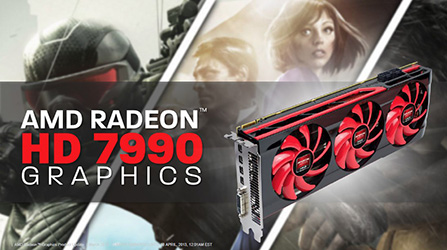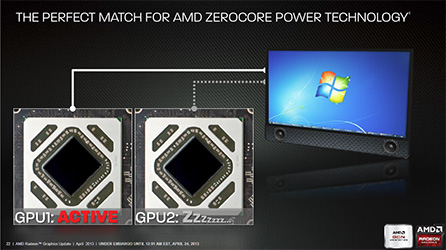 156
156
AMD Radeon HD 7990 6 GB Review
The Card »Introduction

Today, AMD launched its reference Radeon HD 7990 dual-GPU graphics card codenamed "Malta". The company's Radeon HD 7900 series preceded NVIDIA's high-end GTX 600 series by three months, yet NVIDIA was, with the launch of the GeForce GTX 690 close to a year ago, the first of the two to launch a dual-GPU graphics card based on its high-end silicon for this generation.
Part of the reason for things playing out as they did was NVIDIA's single-GPU flagship at the time, the GeForce GTX 680. Not only did it outperform AMD's Radeon HD 7970 GHz Edition, but it also made an attempt at a dual-GPU card by AMD futile. AMD's Radeon HD 7970 GHz Edition caught up with the GTX 680 in June, albeit at a significant power-draw cost that made a reference dual-GPU card all the more unfit for reference design treatment, since the GTX 690 showed near-perfect performance upscaling over the GTX 680 and exceptionally good power-draw. AMD's HD 7990, codenamed "New Zealand" on the company's roadmaps, was in jeopardy. The company did allow its board partners to come up with their own board designs that used a pair of HD 7970 GPUs, but those cards usually required three power connectors and triple-slot cooling solutions. AMD's 2012 clearly didn't end as well as the company had hoped for, at least in the extreme segment. By the turn of the year, AMD dropped hints that it hadn't given up on the reference HD 7990, adding that efforts to make this summer's high-end GPU segment interesting were well on their way.
The Radeon HD 7990 we have with us today is a far cry from the amp-guzzling "New Zealand" cards of 2012, so much so that AMD codenamed it "Malta." It makes do with a dual-slot cooling solution and draws power through two instead of three power connectors. It uses a pair of 28 nm "Tahiti" GPUs with all their physical components unlocked: the full complement of 2,048 stream processors, full 384-bit memory bus width, and clock speeds that don't look compromised. The core is clocked at a respectable 1.00 GHz, and its memory comes at 6.00 GHz. The card uses AMD's ZeroCore technology, which allows it to completely power down the card's second GPU outside of gaming.
Figuring out how the new HD 7990 "Malta" performs and whether its scaled down cooling and power connector requirements come at a cost will be a fascinating challenge. The card itself costs $1000 and will be available in stores within roughly two weeks.
| Radeon HD 7970 | HD 7970 GHz Ed. | GeForce GTX 680 | GeForce GTX 590 | GeForce GTX Titan | GeForce GTX 690 | Radeon HD 7990 | |
|---|---|---|---|---|---|---|---|
| Shader Units | 2048 | 2048 | 1536 | 2x 512 | 2688 | 2x 1536 | 2x 2048 |
| ROPs | 32 | 32 | 32 | 2x 48 | 48 | 2x 32 | 2x 32 |
| Graphics Processor | Tahiti | Tahiti | GK104 | 2x GF110 | GK110 | 2x GK104 | 2x Tahiti |
| Transistors | 4310M | 4310M | 3500M | 2x 3000M | 7100M | 2x 3500M | 2x 4310M |
| Memory Size | 3072 MB | 3072 MB | 2048 MB | 2x 1536 MB | 6144 MB | 2x 2048 MB | 2x 3072 MB |
| Memory Bus Width | 384 bit | 384 bit | 256 bit | 2x 384 bit | 384 bit | 2x 256 bit | 2x 384 bit |
| Core Clock | 925 MHz | 1050 MHz | 1006 MHz+ | 607 MHz | 837 MHz+ | 915 MHz+ | 1000 MHz |
| Memory Clock | 1375 MHz | 1500 MHz | 1502 MHz | 855 MHz | 1502 MHz | 1502 MHz | 1500 MHz |
| Price | $400 | $440 | $420 | $750 | $1000 | $1000 | $1000 |
Apr 16th, 2024 18:28 EDT
change timezone
Latest GPU Drivers
New Forum Posts
- Is there any scientific reason airplanes don't get weighed before take off? (27)
- Asus 7 PIN fans to standard 4 pin PWM? (7)
- Battery swap for cyberpower UPS (39)
- Which air cooler for a ryzen 9 5900x (151)
- Are there RGB lit split keyboards? (6)
- Time to update the motherboards layout! (109)
- NVCleanInstall Error: Access to the path ”DisplayDriverExt.dll” is denied. (8)
- Strange behaviour with my i5 1235u HP laptop after Windows reinstall (12)
- Outer Worlds getting boring (28)
- Visually does this GPU seem to have any problems? (12)
Popular Reviews
- Horizon Forbidden West Performance Benchmark Review - 30 GPUs Tested
- PowerColor Radeon RX 7900 GRE Hellhound Review
- Galax GeForce RTX 4070 Super EX Review
- Fractal Design Terra Review
- ASUS GeForce RTX 4090 Matrix Platinum Review - The RTX 4090 Ti
- Corsair 2000D Airflow Review
- Minisforum EliteMini UM780 XTX (AMD Ryzen 7 7840HS) Review
- Creative Pebble X Plus Review
- FiiO KB3 HiFi Mechanical Keyboard Review - Integrated DAC/Amp!
- ASUS GeForce RTX 4090 STRIX OC Review
Controversial News Posts
- NVIDIA Points Intel Raptor Lake CPU Users to Get Help from Intel Amid System Instability Issues (102)
- US Government Wants Nuclear Plants to Offload AI Data Center Expansion (98)
- Sony PlayStation 5 Pro Specifications Confirmed, Console Arrives Before Holidays (97)
- Developers of Outpost Infinity Siege Recommend Underclocking i9-13900K and i9-14900K for Stability on Machines with RTX 4090 (82)
- Windows 10 Security Updates to Cost $61 After 2025, $427 by 2028 (79)
- TechPowerUp Hiring: Reviewers Wanted for Motherboards, Laptops, Gaming Handhelds and Prebuilt Desktops (70)
- Intel Realizes the Only Way to Save x86 is to Democratize it, Reopens x86 IP Licensing (70)
- AMD Zen 5 Execution Engine Leaked, Features True 512-bit FPU (63)

